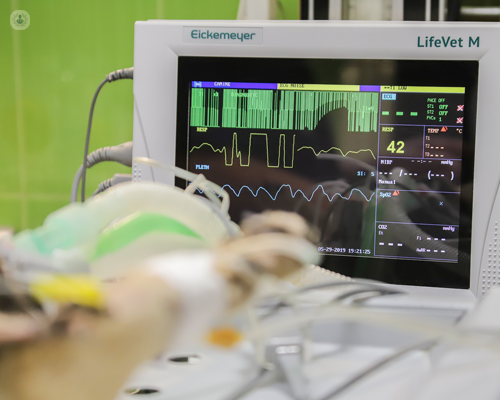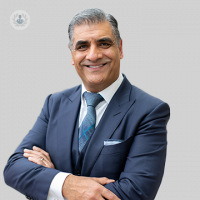Coronary artery disease (CAD) treatment: A guide to beating heart bypass surgery
Written by:Heart surgery, and more specifically, beating heart bypass surgery, can be a daunting procedure for patients with coronary artery disease (CAD). They may have many questions about what takes place, especially if they are new to the situation.
Top Doctors speaks to experienced traditional and keyhole heart surgeon Mr Inderpaul Birdi, for a reassuring and comprehensive look at beating heart bypass surgery, keyhole surgery versus traditional approaches and the benefits and risks of the procedure.

What is beating heart bypass surgery and when is it required?
Beating heart surgery is exactly as the title suggests. It is performing bypass grafts to blocked heart arteries without stopping the heart and leaving it beating.
Traditionally, when we do coronary artery bypass grafting, we use a heart lung machine to support the circulation and the work of the lungs. We also stop the heart so it is rendered very still. During this period of time, we can accurately stitch new grafts to the small coronary arteries.
In beating heart coronary artery surgery, what we're doing is leaving the heart beating and using special equipment to stabilise parts of the heart where the target artery is, so that we can open it and perform the bypass graft.
Do the heart and lungs continue to perform during the procedure?
When we use a procedure where we stop the heart, we have to support the circulation and the lungs. Traditionally we use something called the cardio-pulmonary bypass machine. Once the patient is placed on the cardio-pulmonary bypass machine, by way of pipes placed strategically into the heart, we can then stop the heart and perform the surgery on a still bloodless field. In beating heart surgery, we leave the heart beating and so therefore the heart continues to support the circulation of the patient, and we leave the lungs working, essentially by using a ventilator because the patient is asleep and can't breathe for themselves. Therefore, the lungs are doing the work of oxygenating the blood, so during beating heart coronary surgery we leave both the heart and the lungs working as they normally would.
What happens during beating heart bypass surgery?
During beating heart surgery, we gain access to the heart and traditionally this is through a breast bone split. We expose the heart and we look at the arteries on the surface of the heart to decide where we want to place the bypass grafts.
Once we have decided this, we can place a device, a bit like the foot of a sewing machine, onto that area of the heart artery to stabilise that small one-centimetre portion of the heart. The rest of the heart continues to beat. We can then open the heart artery at that precise point and stitch the new bypass graft into position.
What makes the procedure potentially tricky for the surgeon?
When the heart is beating it can be more difficult to identify the exact and precise point where one would want to place the new bypass graft.
In addition, the anaesthetist and the surgeon have to work very closely together to ensure that we can maintain the blood pressure and adequate circulation during the surgery.
This is actually not particularly difficult to do if communication is maintained and there is significant experience between the clinical teams.
What are the benefits versus the risks of beating heart bypass surgery?
Traditionally, beating heart surgery proponents believe that by avoiding cardio-pulmonary bypass, we can avoid some of the complications associated with using the heart-lung machine. Clearly, when we put pipes into the heart, they can create damage. When we take blood from the human body and put it through plastic pipes and the machine, that can alter the way the blood would normally work. So that when we use the heart-lung machine we see a number of different effects on the human body which are usually subtle, but in certain patients can be quite profound.
These sorts of effects include:
- Disturbing the way that the blood clots, so that after heart surgery using the heart-lung machine, we see something called coagulopathy where the blood doesn't clot properly and bleeding complications can occur post-operatively
- The other thing we also notice is that, using the heart-lung machine can interfere with the immune system so that the immune system can be suppressed
- The third thing that we see is something called systemic inflammatory response. When we take the blood out of the patient and we return it to them, in every patient there is a degree of systemic inflammatory response. But in some patients, this can be quite profound. And this can create damage to the organs of the body, including the lungs, the liver and the kidneys. I can create a situation where the blood pressure can be rendered very low because the arteries in the body become very dilated and so it's very difficult to maintain adequate blood pressure. This systemic inflammatory response can be treated with drugs and in some cases, when very extreme, can be extremely difficult to treat
I would say though, generally, the use of the lung-heart machine is very safe and effective and has been used for many decades to provide an opportunity for surgeons to perform all types of heart surgery, both within the heart and on the surface of the heart.
What is different about coronary artery surgery on the beating heart is that the coronary arteries lie on the surface of the heart, and so we don't have to open the heart and therefore, coronary artery bypass surgery often lends itself very well to leaving the heart beating and the lungs working.
Can keyhole heart surgery be performed on the beating heart?
Keyhole heart surgery, like the procedures performed at the Keyhole Heart Clinic, can be used to bypass one artery or many arteries on the surface of the heart, using the techniques that we have learnt when using beating heart surgery.
The heart is placed gently into various positions in order to allow it to maintain the patient's blood pressure and circulation. The lungs continue to be allowed to work to ensure that the blood is oxygenated, and we use special devices just like when we perform beating heart surgery through the breastbone to stabilise the very precise portions of the heart artery that we want to bypass.
The only difference between keyhole surgery on the beating heart and traditional surgery to the breast bone on the beating heart, is simply that by avoiding a breastbone cut, we can allow the patient to heal much more quickly because the small cut that we make between the ribs on the left-hand side heals in six or seven days, whereas the breastbone can take twelve weeks to heal.
Patient often return to normal activity between two to three weeks after keyhole coronary artery bypass grafting, whereas through the breastbone it can take twelve weeks before a patient can return to full normal activities like exercising or playing golf, for example.
If you require heart surgery, including beating heart bypass surgery, and are interested in the expertise that Mr Birdi and his clinic, Keyhole Heart Clinic, can offer, make an appointment via his Top Doctors profile, here.


